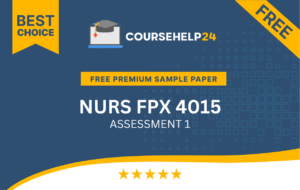NURS FPX 4015 Assessment 2: Introduction
Holistic nursing care aims to restore the body, mind, and spirit of the whole individual rather than only treating the symptoms of physical illness. To enhance overall health and psychological results, this approach incorporates physical, social, psychological, and spiritual components. The 3Ps pathophysiology, pharmacology, and physical assessment are a solid basis that nurses need to provide safe, effective, and customized care (Weeder, 2023). In NURS FPX 4015 Assessment 2, the importance of holistic nursing is highlighted in terms of the role of the 3Ps in clinical practice and how implementing all of them can enhance patient-centered care.
The Importance of Holistic Nursing Care
According to the sources of the American Holistic Nurses Association (AHNA, 2021), the term holistic care nursing means the therapeutic interactions of medical interventions with complementary therapies, such as stress management and mindfulness techniques. Patient outcomes, adherence, and patient satisfaction are enhanced when a patient’s physical, emotional, social, and spiritual needs are met. As demonstrated in NURS FPX 4015 Assessment 2, the key role of merging such holistic practices with the 3Ps relates to its ability to increase the capacity of the nurses to deliver safe, efficient, and patient-centered care.
Relying on a holistic mindset, nurses will be capable of supplementing their clinical decision-making, their work with patients, and advocacy with their understanding of pathophysiology and pharmacology. Moreover, it has been disclosed that holistic care might make nursing practitioners experience a reduced burnout rate and higher job satisfaction (Lukovsky et al., 2020). The NURS FPX 4015 Assessment 2 shows that by integrating the 3P into this plan, nurses will be capable of giving comprehensive and personalized care that can be technologically adjusted to the needs of this particular patient.
The Role of the 3Ps in Holistic Nursing Care
| Perspective | Function in Nursing Practice | An illustration in a clinical setting |
| Pathophysiology | Understands the origins of disease and foresees issues. | A nurse who treats a patient with Type 2 diabetes and provides nursing and holistic care simultaneously educates the patient about insulin resistance and keeps an eye out for cardiovascular and neuropathy problems (Park, 2021). |
| Pharmacology | Ensures that drugs are given safely and examines the therapeutic effects. | As for adherence, when treating a depressed patient, the effectiveness and adverse effects of SSRIs are part of a holistic nursing care plan (Thom et al.). |
| Physical Examination | Identifies abnormalities and offers advice | A nurse may use oxygen therapy, diuretics, and fluid restriction when a patient with heart failure has crackles (Patiwael et al., 2021). |
Application of the 3Ps in Clinical Practice
In treating complex medical illnesses, pathophysiology, pharmacology, and physical examination are the three roles that should be blended together and used through a process called nursing holistic care. Another example is that nurses with an understanding of the pathophysiology of chronic airway inflammation could better make regular respiratory evaluations of patients with chronic obstructive pulmonary disease. Lung functioning is enhanced with the help of pharmacological corticosteroids and bronchodilators (MacLeod et al., 2021). The NURS FPX 4015 Assessment 2 indicates that a nurse may ensure that the hypertension of a chronic condition can be dealt with safely, efficiently, and patient-focused with the aid of the policy of The 3Ps in
addressing a problem such as COPD. The immediate and quick solutions are informed by the physical examination of the patient, which entails oxygen saturation levels and detection of a wheeze in the patient, as seen in holistic care in nursing examples.
Similarly, holistic care in nursing emphasizes the role of systemic inflammation, including the possibility of organ dysfunction, on early diagnosis and intervention in sepsis treatment. Regular physical assessments can be used to recognize a reduced level in time by means of checking vital signs and urine production. Stabilization requires pharmacological treatment, such as the implementation of antibiotics and vasopressors (Thom et al., 2021). Using the 3Ps in such scenarios leads to early detection and evidence-based management of fatal conditions such as sepsis as demonstrated in NURS FPX 4015 Assessment 2.
Conclusion
Patient safety is greatly increased when the 3Ps are incorporated into holistic nursing care, which also leads to better outcomes and more individualized treatment plans. Nurses are able to handle all of the patients’ demands because evidence-based pharmaceutical measures, thorough physical examinations, and knowledge of the illnesses’ origins may meet all of the patients’ needs. As emphasized in NURS FPX 4015 Assessment 2, the 3Ps method ultimately enables nurses to deliver exceptional, compassionate, and patient-centered care.
References
American Holistic Nurses Association. (2021). What we do. https://www.ahna.org/About- Us/What-is-Holistic-Nursing
Lukovsky, J., McGrath, E., Sun, C., Frankl, D., & Beauchesne, M. A. (2020). A survey of hospice and palliative care nurses’ and holistic nurses’ perceptions of spirituality and spiritual care. Journal of Hospice & Palliative Nursing, 23(1), 28–37. https://doi.org/10.1097/njh.0000000000000711
MacLeod, M., Papi, A., Contoli, M., Beghé, B., Celli, B. R., Wedzicha, J. A., & Fabbri, L. M. (2021). Chronic obstructive pulmonary disease exacerbation fundamentals: Diagnosis, treatment, prevention and disease impact. Respirology, 26(6), 532–551. https://doi.org/10.1111/resp.14041
Park, J. J. (2021). Epidemiology, pathophysiology, diagnosis and treatment of heart failure in diabetes. Diabetes & Metabolism Journal, 45(2), 146–157. https://doi.org/10.4093/dmj.2020.0282
Patiwael, J. A., Douma, A. H., Bezakova, N., Kusurkar, R. A., & Daelmans, H. E. M. (2021). Collaborative testing in physical examination skills training and the autonomous motivation of students: A qualitative study. BMC Medical Education, 21(1). https://doi.org/10.1186/s12909-021-02618-7
Thom, R. P., Alexander, J. L., Baron, D., Garakani, A., Gross, L., Pine, J. H., Radhakrishnan, R., Slaby, A., & Sumner, C. R. (2021). Selective serotonin reuptake inhibitors: How long is long enough? Journal of Psychiatric Practice, 27(5), 361–371. https://doi.org/10.1097/pra.0000000000000578
Weeder, S. (2023). Preparing nurse practitioners to address planetary health and climate change. Nurse Educator, 48(6), e342. https://doi.org/10.1097/nne.00000





